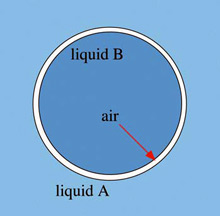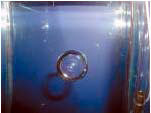| 2005 |

|
YEAR BOOK |
Loreto College Coleraine, Derry
|
Antibubbles
|
An antibubble is a pocket of liquid enclosed within a layer of air, the entire body is surrounded by a liquid. A normal bubble is the opposite in that it consists of a pocket of air surrounded by a thin film of liquid, entirely surrounded by air.


Both methods of determining the air volume suggested that this value remains constant irrespective of the overall size of the bubble. We found the thickness of the air film in the antibubble to be about 2x10 -5 m. We also used sodium light to see interference patterns in antibubbles but were unable to count the rings to estimate thickness.
In addition we derived a formula to calculate the variation of air thickness with depth so that the minimum thickness of an air film could be found by sending antibubbles to the bottom of the tank.
Martin Quigg and Benjamin Mc Killen won first prize in the Intermediate Group Section in the Chemical & Physical Sciences Category at the EsatBT Young Scientist & Technology Exhibition in January 2005. They also won a special award presented by The Institute of Physics. Their teacher was Mr Brian Mc Kenna.
| This article was sponsored by The Institute of Physics |
|---|